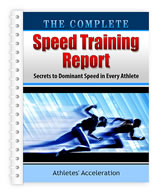Acceleration Speed DevelopmentAcceleration Speed is a product of stride length (the distance your hips travel in a stride) and stride frequency (the number of steps you take in a given time period). However, you will not reach top speed by focusing on increasingly larger steps to increase stride length or taking short, quick steps to increase stride frequency. Instead, top speeds are created by applying 'optimal' force to the ground. Both length and frequency are improved by strength so better strength application results in faster speeds. Really, acceleration training is a form of strength training. Ground contact times (the amount of time each foot spends on the ground) are another important factor to consider during acceleration. During the earliest parts of acceleration, especially the first two steps, you are trying to overcome (inertia) the weight of your body by moving it forward as quickly as possible. This takes a great deal of strength and power. The stronger and more efficient you are, the more you can extend your acceleration phase. Since high intensity sprint work involves recruiting specific groups of muscle fibers improves the efficiency of neuromuscular firing patterns, sprinting is taxing to the central nervous system. Once the CNS becomes fatigued, workouts quickly lose their effectiveness. Any type of speed training must be done with full recovery. Generally speaking, that means approximately one minute of rest for every 10 yards that you run. Sprinting is a highly technical activity. Without full recovery, both your muscles and your central nervous system will begin to fatigue quickly, reducing the short and long term effectiveness of your training. For this reason, acceleration should not be trained with fatigue present. To optimize your success, full recovery must be adhered to both in your individual workouts as well as your weekly plan. It takes roughly 36-48 hours to fully recover from a speed workout.
Acceleration Cues
• Drive out so the body is at a 45 degree angle to the ground. • Keep the heel recovery low during the first 6-8 strides. • Drive the elbows down and back. Keep the hands loose, but not open. Arms should remain at approximately 90 degrees from the elbow. • Step over the opposite knee and drive the foot down into the ground to create maximal force. Don’t force yourself to ‘stay low’. This will limit the amount of force you can apply to the ground and leads to poor acceleration. Let your upper body unfold naturally. ‘Staying low’ will occur naturally if you are already strong enough.
At the beginning of your training season acceleration work is used. You can't be efficient running longer distances without getting the proper strength levels and neuromuscular efficiency of the shorter intervals. As your athletes get stronger, you can extend out the acceleration distances. You want your athletes to be driving out as far as possible. The stronger the athlete is the further the acceleration phase will be and will set-up the athletes' top speed better later on. During acceleration, the foot should strike directly below or slightly behind the hips. You must be able to drive out so your body is at a 45 degree angle to the ground and step over the opposite knee and drive the foot down into the ground to create maximal force. Horizontal to Vertical Some athletes aren’t strong enough to hold and maintain that ideal drive phase. So, you must trick the athlete's body and make it so that they have to get into the right position. Start your acceleration speed work on the ground and work your way up. In order to put the athletes in the best mechanical position, even without great strength levels, athletes will start with short intervals, in a horizontal position. As the athletes get stronger, the acceleration intervals are lengthened and/or the starting positions are more vertical.
Click Here to Go Back to the
Related Articles: Speed Training | 4 Most Important Words that Improve Speed | Linear Speed Development | Summer Training for Speed | Summer Training for Speed - Part II | Speed Coach | Speed Coach of the Year | Top Speed Training | Acceleration Speed Development | Goal Setting for Speed Athletes | Speed Training Practice | New Breed of Speed Coach | Acceleration Speed Training | MOST Important part of speed training | Strength Training for Speed and Power Athletes | Conditioning Workouts for Speed Athletes | Speed Training Conditioning
|
|||||
